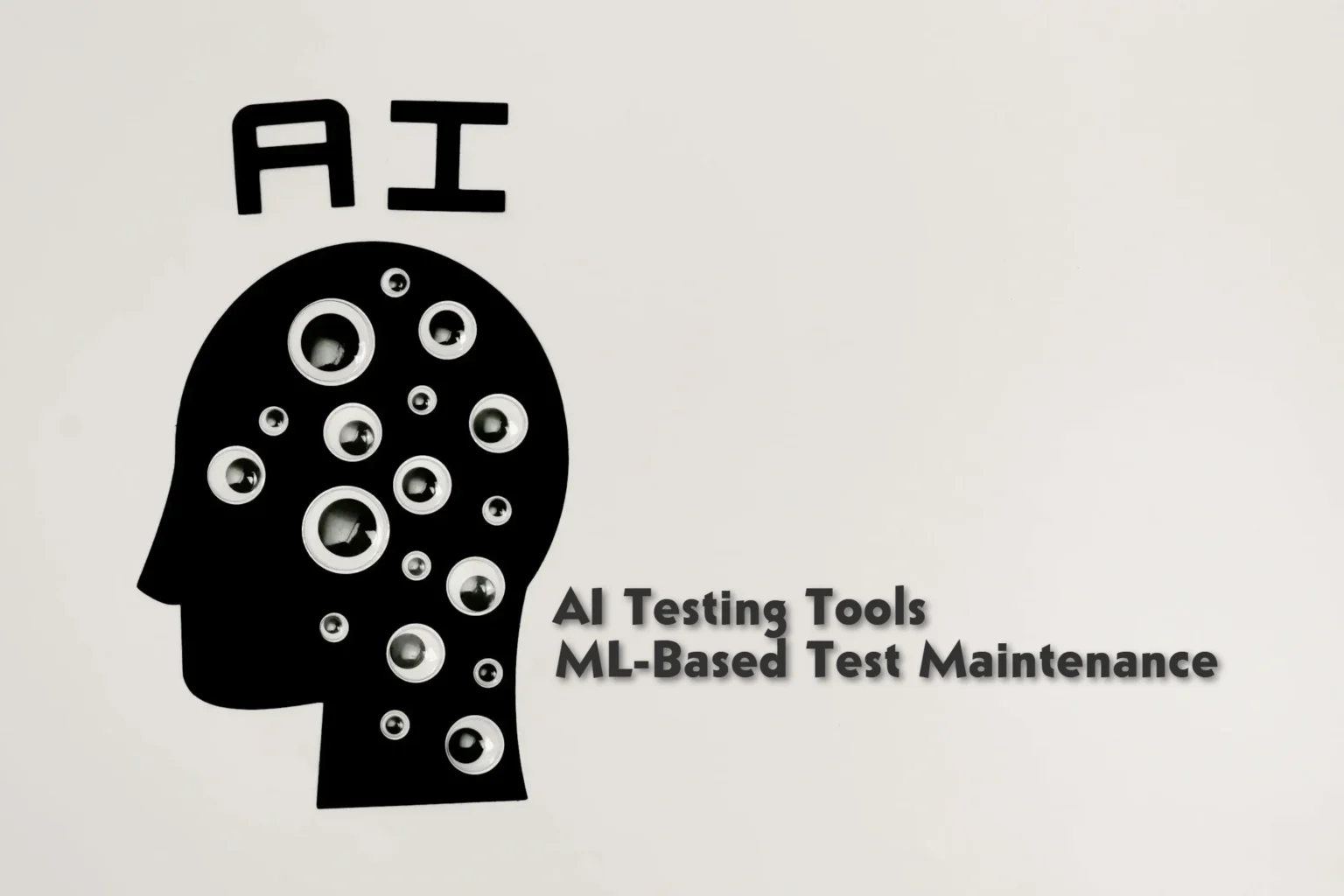Test maintenance has emerged as one of the largest problems software teams face in modern development landscapes, particularly in agile and DevOps implementation, where code updates occur regularly. The conventional method of test case maintenance implies performing manipulative changes to test cases, which turns time-consuming and error-prone.
This is where Machine Learning (ML)-based Test Maintenance comes in to change the approach entirely when handling and optimizing test cases. The application of machine learning algorithms means that many features of a test maintenance process can be automatic, which contributes to making software testing more efficient, reliable, and scalable.
This article on AI testing tools discusses why test maintenance should include the elements of the ML-based approach and how machine learning improves test reliability; it also defines the main approaches and challenges of using machine learning within the test maintenance process and cites the current best practices of its implementation.
Why is Test Maintenance Critical in Software Testing?
Staying current in software testing is important, but having a solid set of test cases to utilize is also essential to have outstanding test cases to work with. Whenever there is a rapid change in code bases, test cases can get out of sync, become less relevant, generate more noise than signal, or fail to expose bugs altogether. This not only influences the speed of conducting tests but also results in the effectiveness of the software that is created.
As far as manual test maintenance is concerned, this is very useful to some extent, but with the CI/CD cycle and shorter development cycles, testing has to be faster. The more complex the software application under test becomes, the more difficult it is to manually apply effective changes to test cases, hence the importance of maintenance automation.
With ML, test maintenance is a revolutionary approach that entails test maintenance automation, test modification to suit the new code base, and enhancing testing effectiveness.
How Machine Learning Enhances Test Maintenance?
- Automatic Update of Test Cases: For effective test maintenance, machine learning algorithms offer a variety of features. Machine learning models can decide when and how to update test cases by examining patterns in code changes and test results and using data. The following are some of the primary roles of machine learning in test maintenance:
- Automatic Test Cases Updating: it predicts which parts of the test case are most likely to go out of date and adjusts the test case itself.
- Prioritization and Optimization of Test Cases: Analyzing test coverage helps determine which ML model might identify critical test cases and could better target tests that code changes would impact.
- Early identification of broken tests: Because of ML-based systems, patterns of broken tests can easily be identified early on in the process so that the development team gets its issues fixed before they create an issue.
- Minimization of Manual Workload: ML-based test maintenance significantly minimizes the time and effort required for manual test updates with more sophisticated tasks.
Key Benefits of ML-Based Test Maintenance
The use of ML-based test maintenance has its own set of advantages which completely alleviate the challenges of performing manual test maintenance:
- Reduced manual effort: The ML algorithms automatically update test cases with fewer human interventions and in much less time.
- Enhanced Test Coverage: ML improves the overall test coverage by indicating the holes in tests based on code complexity and frequency of change.
- Efficient Utilization of Resources: It frees the testers up precious testing time for high-value tasks, optimizing a team’s productivity.
- Early Detection of Potential Failures: ML can sense potential failures by identifying trends or anomalies in test results and hence gives early warnings in case some issues may affect the software quality.
- Improved Agility in Development: The ML-based test maintenance approach is faster, and test updates are quicker, preventing delays in a development cycle.
Popular Machine Learning Techniques Used in Test Maintenance
Machine learning offers a variety of techniques that are useful for efficiently maintaining test cases. In test maintenance, some of the most used machine learning techniques are as follows:
- Classification Algorithms: Some algorithms classify test cases as active, obsoleted, or needing modification, and this can help focus maintenance efforts on the most appropriate use of time.
- Clustering: It is used for grouping similar test cases and mass updating; it will also highlight the redundant or low-value test cases.
- Test anomalies: This technique is based on anomaly detection. This technique finds unusual patterns of test results that can indicate a possible test failure or outdated test cases.
- Natural Language Processing (NLP): NLP aids in the testing script analysis and updating by understanding any kind of change in the documentation or comments in the code, ensuring that tests remain in sync with requirements.
Types of ML-Based Test Maintenance Approaches
Several ML-driven strategies have come forward to improve test maintenance in DevOps and agile scenarios. Some of the primary approaches include:
- Self-Healing Tests: This is one of the significant features where the ML algorithms detect broken test scripts and auto-correct or update these according to the latest codebase.
- Impact Analysis Test: This is one of the ML techniques that analyzes code changes and their effects on test cases. That helps run selective tests and saves time during the testing process.
- Predictive Maintenance: Using the trends from historical data, predictive models predict what test failures may be ahead. This enables teams to confront problems before they cause tests to break, reducing the likelihood of broken tests.
Integrating ML-Based Test Maintenance in CI/CD Pipelines
Incorporating machine learning (ML)-based test maintenance into your continuous integration and deployment (CI/CD) pipelines can unlock remarkable benefits. By seamlessly integrating these technologies, you can achieve real-time test updates, selective test execution, and continuous monitoring of test health.
As new code is deployed, the ML models adapt the test cases, ensuring they remain relevant and accurate. This dynamic approach eliminates the need for manual test updates, saving time and resources. Furthermore, test impact analysis tools within the pipeline help execute only the affected tests, reducing testing time and increasing overall efficiency.
Continuous monitoring of test results with the ML-based tool allows one to identify patterns and anomalies and proactively address problematic conditions to prevent them from becoming bigger issues. Proactive testing ensures reliability and quality in your software deliveries.
You will be able to streamline your development process, accelerate software delivery, and preserve the integrity of your testing once you implement ML-driven test maintenance into your CI/CD workflows.
Challenges and Limitations of ML-Based Test Maintenance
Although there are many benefits to integrating ML-based test maintenance into CI/CD pipelines, it’s crucial to be conscious of the potential downsides and limitations.
The availability of data is one of the main hurdles. Large datasets are essential for machine learning algorithms to forecast test maintenance requirements accurately. Smaller projects or organizations could struggle with a lack of data to train and optimize their machine-learning models properly.
Furthermore, the accuracy of the ML models is essential. False positives or negatives resulting from inaccurate forecasts may eventually affect the tests’ reliability. It is crucial to ensure test integrity by ensuring the models are properly trained and regularly evaluated.
It can also be necessary to modify workflows and procedures to integrate ML-based tools into current testing environments and CI/CD pipelines. For the new technologies to be implemented smoothly, this integration complexity may result in extra costs and the requirement for specialist knowledge.
Lastly, it’s important to consider the substantial initial setup expenses related to ML-based test maintenance. For some businesses, purchasing the required equipment, instruction, and data management infrastructure might be an expensive initial investment.
Despite these difficulties, companies dedicated to optimizing their development processes should give ML-based test maintenance greater consideration because of the long-term advantages of increased software testing accuracy and efficiency.
Best Practices for Implementing ML-Based Test Maintenance
- Regular Model Training: Stay on top of your game by updating your ML models with the latest data. This helps improve the accuracy and relevance of your test predictions.
- Human Oversight: Combining automated maintenance with manual validation is key. This ensures high-quality results and helps catch any false positives that slip through.
- Monitor Model Performance: Keep a close eye on your ML models’ performance. Track their effectiveness in adapting to your evolving codebase. This helps you spot any issues early on.
- Focus on Scalability: Choose tools and solutions that can scale with your project as it grows. This guarantees long-term value and ensures your ML-based test maintenance stays strong.
Future of ML-Based Test Maintenance
The future of ML-based test maintenance looks exciting, starting with having a fully autonomous system that can handle all test maintenance needs with minimal human involvement. Improved prediction models will mean test maintenance is even more proactive and will foresee and prevent test failures before they happen.
With real-time adaptability, future ML-based maintenance tools can handle changes in code faster and find their space among other tasks within a fast-moving development environment. Much of your tests will be efficient, up-to-date and less manual work by you and your team with more strategic use of your time. The future of test maintenance continues to get smarter and more automated.
ML Test Maintenance with AI-Powered LambdaTest
Automating the testing process can be a game-changer, but keeping up with the pace of development can be a challenge. Fortunately, LambdaTest’s HyperExecute and KaneAI are here to help.
HyperExecute brings self-healing capabilities to your testing toolkit, making automated testing more resilient and reliable as your development cycle accelerates. By integrating these AI-powered technologies, your team can maximize the benefits of automation, allowing you to focus on critical testing objectives while the AI handles routine maintenance.
KaneAI, one of the best AI testing tools on the market, is an AI-powered smart test assistant designed for high-speed quality engineering teams. It automates various aspects of the testing process, including test case authoring, management, and debugging, helping you streamline your testing workflows and deliver high-quality results faster.
Conclusion
ML-based test maintenance is a giant leap forward in software testing. Here, adopting machine learning enables teams to automate time-consuming tasks quickly, including test maintenance with minimal effort and manual operation, which enhances reliability in tests and agility in development.
There are challenges to be considered; however, ML-driven test maintenance has strong capabilities when it comes to optimizing testing workflows to ensure higher quality for the software, and thus, the tool is indispensable for forward-thinking development teams.


